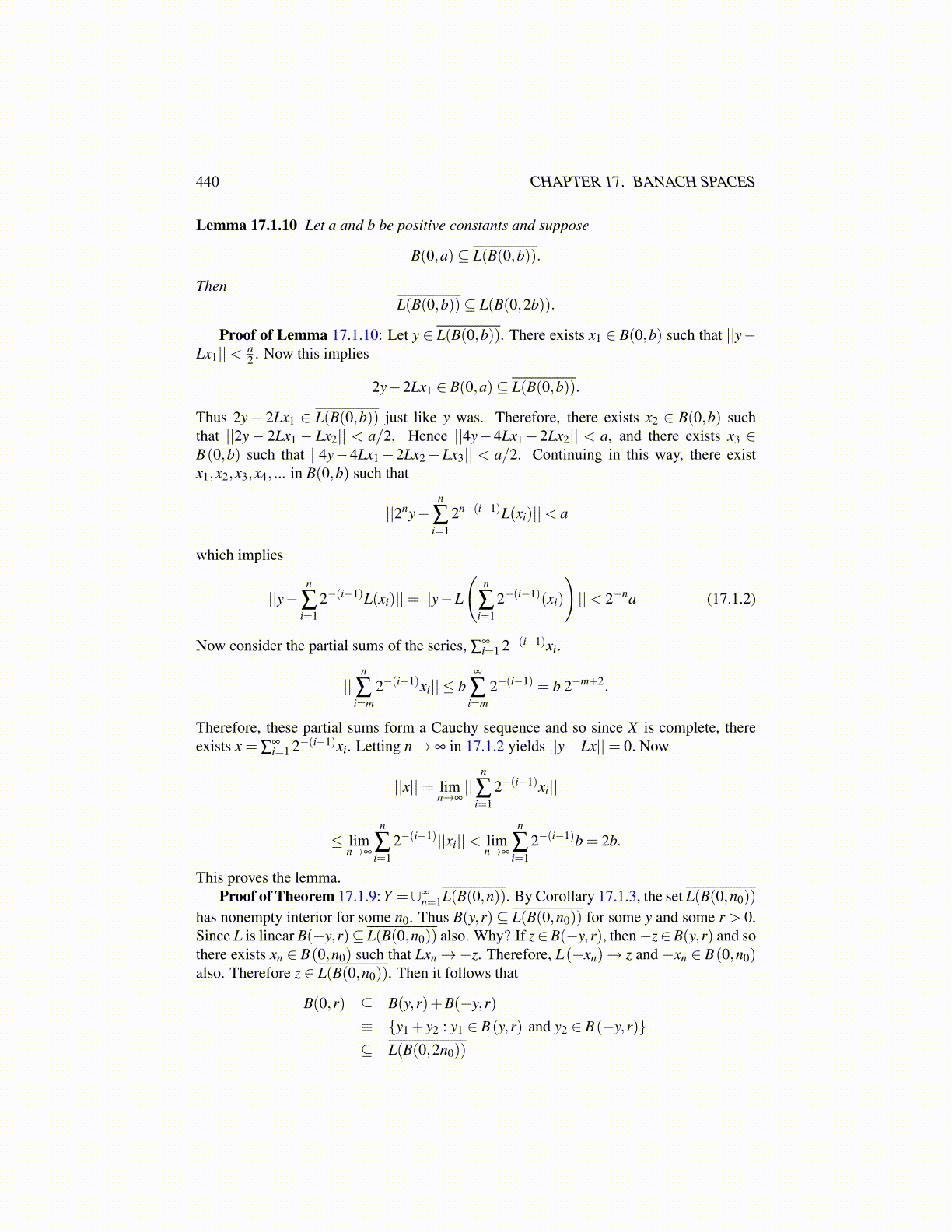
440 CHAPTER 17. BANACH SPACES
Lemma 17.1.10 Let a and b be positive constants and suppose
B(0,a)⊆ L(B(0,b)).
ThenL(B(0,b))⊆ L(B(0,2b)).
Proof of Lemma 17.1.10: Let y ∈ L(B(0,b)). There exists x1 ∈ B(0,b) such that ||y−Lx1||< a
2 . Now this implies
2y−2Lx1 ∈ B(0,a)⊆ L(B(0,b)).
Thus 2y− 2Lx1 ∈ L(B(0,b)) just like y was. Therefore, there exists x2 ∈ B(0,b) suchthat ||2y− 2Lx1 − Lx2|| < a/2. Hence ||4y−4Lx1−2Lx2|| < a, and there exists x3 ∈B(0,b) such that ||4y−4Lx1−2Lx2−Lx3|| < a/2. Continuing in this way, there existx1,x2,x3,x4, ... in B(0,b) such that
||2ny−n
∑i=1
2n−(i−1)L(xi)||< a
which implies
||y−n
∑i=1
2−(i−1)L(xi)||= ||y−L
(n
∑i=1
2−(i−1)(xi)
)||< 2−na (17.1.2)
Now consider the partial sums of the series, ∑∞i=1 2−(i−1)xi.
||n
∑i=m
2−(i−1)xi|| ≤ b∞
∑i=m
2−(i−1) = b 2−m+2.
Therefore, these partial sums form a Cauchy sequence and so since X is complete, thereexists x = ∑
∞i=1 2−(i−1)xi. Letting n→ ∞ in 17.1.2 yields ||y−Lx||= 0. Now
||x||= limn→∞||
n
∑i=1
2−(i−1)xi||
≤ limn→∞
n
∑i=1
2−(i−1)||xi||< limn→∞
n
∑i=1
2−(i−1)b = 2b.
This proves the lemma.Proof of Theorem 17.1.9: Y =∪∞
n=1L(B(0,n)). By Corollary 17.1.3, the set L(B(0,n0))
has nonempty interior for some n0. Thus B(y,r)⊆ L(B(0,n0)) for some y and some r > 0.Since L is linear B(−y,r)⊆ L(B(0,n0)) also. Why? If z∈B(−y,r), then−z∈B(y,r) and sothere exists xn ∈ B(0,n0) such that Lxn→−z. Therefore, L(−xn)→ z and −xn ∈ B(0,n0)also. Therefore z ∈ L(B(0,n0)). Then it follows that
B(0,r) ⊆ B(y,r)+B(−y,r)
≡ {y1 + y2 : y1 ∈ B(y,r) and y2 ∈ B(−y,r)}⊆ L(B(0,2n0))